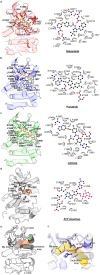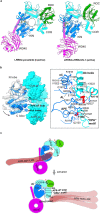Pharmacology of LRRK2 with type I and II kinase inhibitors revealed by cryo-EM
- PMID: 38263358
- PMCID: PMC10805800
- DOI: 10.1038/s41421-023-00639-8
Pharmacology of LRRK2 with type I and II kinase inhibitors revealed by cryo-EM
Erratum in
-
Author Correction: Pharmacology of LRRK2 with type I and II kinase inhibitors revealed by cryo-EM.Cell Discov. 2024 Feb 26;10(1):23. doi: 10.1038/s41421-024-00660-5. Cell Discov. 2024. PMID: 38409077 Free PMC article. No abstract available.
Abstract
LRRK2 is one of the most promising drug targets for Parkinson's disease. Though type I kinase inhibitors of LRRK2 are under clinical trials, alternative strategies like type II inhibitors are being actively pursued due to the potential undesired effects of type I inhibitors. Currently, a robust method for LRRK2-inhibitor structure determination to guide structure-based drug discovery is lacking, and inhibition mechanisms of available compounds are also unclear. Here we present near-atomic-resolution structures of LRRK2 with type I (LRRK2-IN-1 and GNE-7915) and type II (rebastinib, ponatinib, and GZD-824) inhibitors, uncovering the structural basis of LRRK2 inhibition and conformational plasticity of the kinase domain with molecular dynamics (MD) simulations. Type I and II inhibitors bind to LRRK2 in active-like and inactive conformations, so LRRK2-inhibitor complexes further reveal general structural features associated with LRRK2 activation. Our study provides atomic details of LRRK2-inhibitor interactions and a framework for understanding LRRK2 activation and for rational drug design.
© 2024. The Author(s).
Conflict of interest statement
The authors declare no competing interests.
Figures





Similar articles
-
Inhibition of Parkinson's disease-related LRRK2 by type I and type II kinase inhibitors: Activity and structures.Sci Adv. 2023 Dec;9(48):eadk6191. doi: 10.1126/sciadv.adk6191. Epub 2023 Dec 1. Sci Adv. 2023. PMID: 38039358 Free PMC article.
-
Capturing Differences in the Regulation of LRRK2 Dynamics and Conformational States by Small Molecule Kinase Inhibitors.ACS Chem Biol. 2023 Apr 21;18(4):810-821. doi: 10.1021/acschembio.2c00868. Epub 2023 Apr 12. ACS Chem Biol. 2023. PMID: 37043829 Free PMC article.
-
Type-II kinase inhibitors that target Parkinson's Disease-associated LRRK2.bioRxiv [Preprint]. 2025 Feb 13:2024.09.17.613365. doi: 10.1101/2024.09.17.613365. bioRxiv. 2025. Update in: Sci Adv. 2025 Jun 6;11(23):eadt2050. doi: 10.1126/sciadv.adt2050. PMID: 39554022 Free PMC article. Updated. Preprint.
-
Current understanding of LRRK2 in Parkinson's disease: biochemical and structural features and inhibitor design.Future Med Chem. 2012 Sep;4(13):1701-13. doi: 10.4155/fmc.12.110. Future Med Chem. 2012. PMID: 22924508 Free PMC article. Review.
-
Leucine-rich repeat kinase 2 inhibitors: a patent review (2006 - 2011).Expert Opin Ther Pat. 2012 Dec;22(12):1415-26. doi: 10.1517/13543776.2012.729041. Epub 2012 Nov 6. Expert Opin Ther Pat. 2012. PMID: 23126385 Review.
Cited by
-
Leucine-rich repeat kinase 2 biomarkers for Parkinson's disease.Biochem J. 2025 May 28;482(11):709-20. doi: 10.1042/BCJ20253099. Biochem J. 2025. PMID: 40437812 Free PMC article. Review.
-
Comparative Molecular Dynamics Reveals How LRRK2 Inhibitors Distinguish G2019S from Wild-Type.Neurochem Res. 2025 Aug 13;50(4):259. doi: 10.1007/s11064-025-04520-w. Neurochem Res. 2025. PMID: 40802138 Free PMC article.
-
Protective Effect of the LRRK2 Kinase Inhibition in Human Fibroblasts Bearing the Genetic Variant GBA1 K198E: Implications for Parkinson's Disease.Neuromolecular Med. 2025 May 21;27(1):42. doi: 10.1007/s12017-025-08864-y. Neuromolecular Med. 2025. PMID: 40397198 Free PMC article.
-
Structural biology of Parkinson's disease-associated leucine-rich repeat kinase 2 (LRRK2).J Biol Chem. 2025 Aug;301(8):110376. doi: 10.1016/j.jbc.2025.110376. Epub 2025 Jun 14. J Biol Chem. 2025. PMID: 40523620 Free PMC article. Review.
-
Cryo-electron tomography reveals the microtubule-bound form of inactive LRRK2.bioRxiv [Preprint]. 2024 Jun 20:2024.06.18.599606. doi: 10.1101/2024.06.18.599606. bioRxiv. 2024. PMID: 38948781 Free PMC article. Preprint.
References
-
- Alexander Boecker C. The role of LRRK2 in intracellular organelle dynamics. J. Mol. Biol. 2023;435:167998. - PubMed
Grants and funding
LinkOut - more resources
Full Text Sources

